Night on the planet - 30 photos from space
Categories: Space
By Pictolic https://pictolic.com/article/night-on-the-planet-30-photos-from-space.htmlWe bring to your attention 30 of the best photos of views of the night side of the Earth taken from the ISS. Photos taken from Marshall Space Flight Center album, NASA

 Aurora over New Zealand, Tasman Sea. (NASA)
Aurora over New Zealand, Tasman Sea. (NASA)
 Milan, Italy. The lights of Milan resemble a checkered fabric pattern. The bright white lights are the historical center of the city, where the Milan Cathedral is located. The dark areas to the north are fields separating small towns. Due to low clouds, some areas appear blurry. Milan is the largest city in Italy and the fifth largest in the European Union. It is one of Europe's transport, commercial and industrial centers and a global center for fashion and culture. The Globalization and World Cities Network has classified it as alpha. (NASA)
Milan, Italy. The lights of Milan resemble a checkered fabric pattern. The bright white lights are the historical center of the city, where the Milan Cathedral is located. The dark areas to the north are fields separating small towns. Due to low clouds, some areas appear blurry. Milan is the largest city in Italy and the fifth largest in the European Union. It is one of Europe's transport, commercial and industrial centers and a global center for fashion and culture. The Globalization and World Cities Network has classified it as alpha. (NASA)
 Tokyo. The photo was taken from a height of 350 km above the Earth. Most of the area in the photo belongs to Tokyo. To the left, just below the middle of the photo, is Yokohama. (NASA)
Tokyo. The photo was taken from a height of 350 km above the Earth. Most of the area in the photo belongs to Tokyo. To the left, just below the middle of the photo, is Yokohama. (NASA)
 River Nile and Sinai Peninsula. (NASA)
River Nile and Sinai Peninsula. (NASA)
 Europe and Africa. At the top of the photo is the boot of Italy and Sicily. Most visible bodies of water are the Mediterranean Sea. To the right of the center is the Adriatic Sea. Part of Tunisia is visible on the left. In the foreground is a docked Russian ship and parts of the ISS. (NASA)
Europe and Africa. At the top of the photo is the boot of Italy and Sicily. Most visible bodies of water are the Mediterranean Sea. To the right of the center is the Adriatic Sea. Part of Tunisia is visible on the left. In the foreground is a docked Russian ship and parts of the ISS. (NASA)
 City lights near the Italian-French border. The ones that stand out the most are Torino (Italy), Lyon and Marseille (France). The island of Corsica is visible at the top of the photo. The surface of the water reflects the bright light of the full moon. At the moment the photo was taken, the ISS was over Luxembourg. Astronauts often take photographs in which moonlight reflected from the Earth's surface is directed directly at them. That is, when taking photographs, they look forward, and not vertically at what is directly below the station. (NASA)
City lights near the Italian-French border. The ones that stand out the most are Torino (Italy), Lyon and Marseille (France). The island of Corsica is visible at the top of the photo. The surface of the water reflects the bright light of the full moon. At the moment the photo was taken, the ISS was over Luxembourg. Astronauts often take photographs in which moonlight reflected from the Earth's surface is directed directly at them. That is, when taking photographs, they look forward, and not vertically at what is directly below the station. (NASA)
 Las Vegas, Nevada. The dark desert is a contrasting background for the brightly lit, regular network of city streets. Downtown Las Vegas is considered the brightest place on Earth, due to the numerous lights of hotels and casinos. McCarran Airport and Nellis Air Force Base appear dark compared to the city streets. To take such a picture at night, astronauts need to manually track the object being photographed with the camera, since the station is moving at a speed of 7 km/sec relative to the Earth's surface. (NASA)
Las Vegas, Nevada. The dark desert is a contrasting background for the brightly lit, regular network of city streets. Downtown Las Vegas is considered the brightest place on Earth, due to the numerous lights of hotels and casinos. McCarran Airport and Nellis Air Force Base appear dark compared to the city streets. To take such a picture at night, astronauts need to manually track the object being photographed with the camera, since the station is moving at a speed of 7 km/sec relative to the Earth's surface. (NASA)
 Cairo and Alexandria, Egypt. (NASA)
Cairo and Alexandria, Egypt. (NASA)
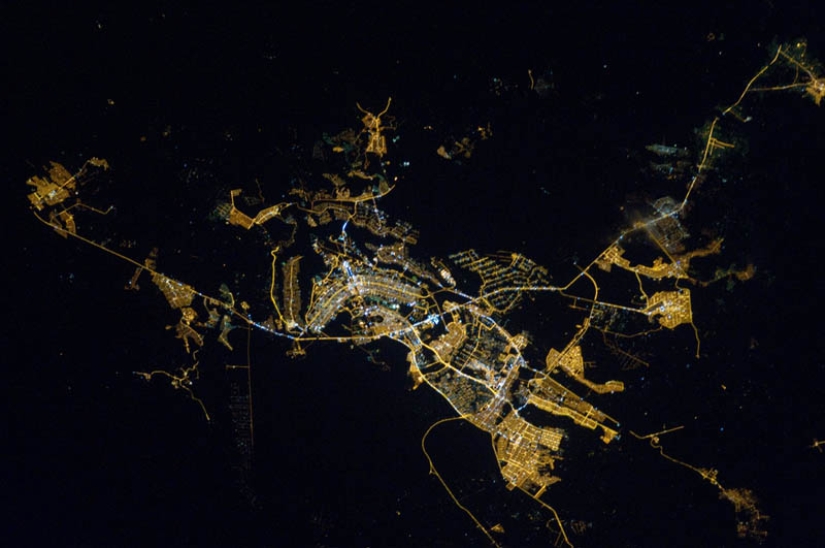 Brasilia, Brazil. From orbit, the capital of Brazil cannot be confused with another city, day or night. It is located on a plateau in the west-central part of the country and is considered one of the best examples of urban planning of the 20th century. One of the distinctive features of the city when viewed from above is the silhouette of a bird (or airplane, or butterfly) moving from northwest to southeast. In the 1960s, other settlements began to grow around the city, and soon satellite cities appeared near the capital. The large unlit area at the bottom left of the photo is a Brazilian National Park. Other dark areas are fields or tropical savanna. (NASA)
Brasilia, Brazil. From orbit, the capital of Brazil cannot be confused with another city, day or night. It is located on a plateau in the west-central part of the country and is considered one of the best examples of urban planning of the 20th century. One of the distinctive features of the city when viewed from above is the silhouette of a bird (or airplane, or butterfly) moving from northwest to southeast. In the 1960s, other settlements began to grow around the city, and soon satellite cities appeared near the capital. The large unlit area at the bottom left of the photo is a Brazilian National Park. Other dark areas are fields or tropical savanna. (NASA)
 San Francisco Bay, California. (NASA)
San Francisco Bay, California. (NASA)
 India-Pakistan border. On the Indo-Gangetic Plain, of the hundreds of luminous spots, the largest are Islamabad (Pakistan) and New Delhi (India). These cities are located approximately 700 km from each other. Roads connecting major cities are also clearly visible. To the north (on the left side of the image) the cloud-covered Himalayas are visible. The orange stripe is the brightest part of the image - the India-Pakistan border. The barriers and bright lighting on it are designed to prevent smuggling and illegal arms trade between countries. (NASA)
India-Pakistan border. On the Indo-Gangetic Plain, of the hundreds of luminous spots, the largest are Islamabad (Pakistan) and New Delhi (India). These cities are located approximately 700 km from each other. Roads connecting major cities are also clearly visible. To the north (on the left side of the image) the cloud-covered Himalayas are visible. The orange stripe is the brightest part of the image - the India-Pakistan border. The barriers and bright lighting on it are designed to prevent smuggling and illegal arms trade between countries. (NASA)
 Montreal. Montreal is the largest city in French-speaking Quebec and the second in the country after Toronto. Major roads and industrial areas are highlighted in white, while residential and commercial areas are illuminated in golden yellow. Rivers and other bodies of water appear black, the earth is illuminated by moonlight. The blur on the left side of the photo is caused by cloudiness. (NASA)
Montreal. Montreal is the largest city in French-speaking Quebec and the second in the country after Toronto. Major roads and industrial areas are highlighted in white, while residential and commercial areas are illuminated in golden yellow. Rivers and other bodies of water appear black, the earth is illuminated by moonlight. The blur on the left side of the photo is caused by cloudiness. (NASA)
 Istanbul. (NASA)
Istanbul. (NASA)
 Northwestern Europe. London, Paris, Brussels and Amsterdam are clearly visible. Milan is also visible in the lower left. For scale, the centers of London and Paris are 340 km apart. (NASA)
Northwestern Europe. London, Paris, Brussels and Amsterdam are clearly visible. Milan is also visible in the lower left. For scale, the centers of London and Paris are 340 km apart. (NASA)
 New Orleans. (NASA)
New Orleans. (NASA)
 Baltimore, Washington. (NASA)
Baltimore, Washington. (NASA)
 Gulf of Mexico. (NASA)
Gulf of Mexico. (NASA)
 Atlantic coast of Europe and Africa. City lights can be traced from Lisbon, across the Strait of Gibraltar and down to the Moroccan coast of Casablanca. (NASA)
Atlantic coast of Europe and Africa. City lights can be traced from Lisbon, across the Strait of Gibraltar and down to the Moroccan coast of Casablanca. (NASA)
 Southern part of Italy. The bottom of the boot and Sicily are illuminated by the lights of Naples, Bara and Brindisi. The Adriatic, Tyrrhenian and Ionian seas appear black. The lights of Palermo and Catania can be seen in the bottom center of the photo. (NASA)
Southern part of Italy. The bottom of the boot and Sicily are illuminated by the lights of Naples, Bara and Brindisi. The Adriatic, Tyrrhenian and Ionian seas appear black. The lights of Palermo and Catania can be seen in the bottom center of the photo. (NASA)
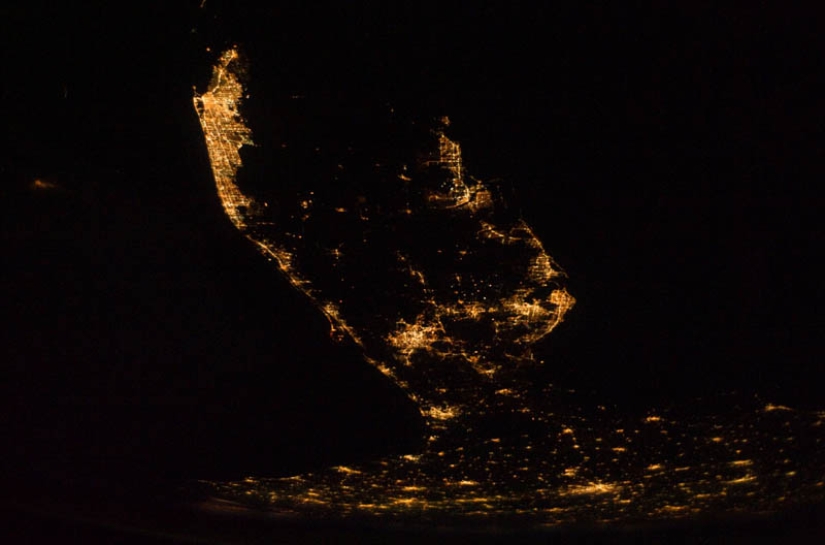 Peninsula Florida. On the left side (on the Atlantic coast) the lights of the brightly lit Cape Canaveral and the Kennedy Space Center are clearly visible. (NASA)
Peninsula Florida. On the left side (on the Atlantic coast) the lights of the brightly lit Cape Canaveral and the Kennedy Space Center are clearly visible. (NASA)
 Houston, Texas. Houston is called the energy capital of the world because of its role in the production of gasoline and other energy products. Houston covers an area of almost 2,331,000 hectares, with an average altitude of only 13 meters above sea level and a population of 5 million people. (NASA)
Houston, Texas. Houston is called the energy capital of the world because of its role in the production of gasoline and other energy products. Houston covers an area of almost 2,331,000 hectares, with an average altitude of only 13 meters above sea level and a population of 5 million people. (NASA)
 Mediterranean Riviera. (NASA)
Mediterranean Riviera. (NASA)
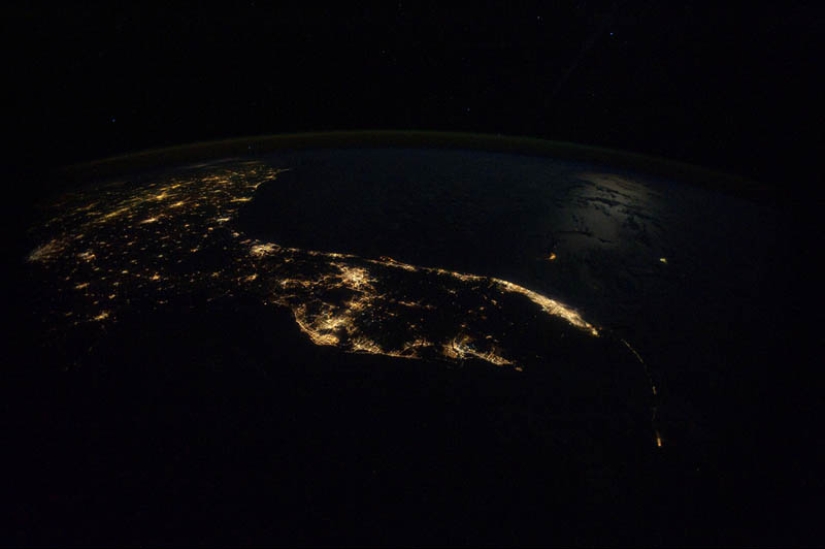 Florida. (NASA)
Florida. (NASA)
 Northern lights over Europe. (NASA)
Northern lights over Europe. (NASA)
 Dubai, UAE. The city of Dubai is the largest settlement in the emirate of Dubai, part of the UAE. It is located in the southern part of the Persian Gulf on the Arabian Peninsula, and is known for its high-rise buildings and high-tech architectural designs. Among the most famous is the Isle of Palms resort, which was created using more than 50 million cubic meters of sand. Work is also underway to create another Palm Tree and an artificial island in the shape of a world map. (NASA)
Dubai, UAE. The city of Dubai is the largest settlement in the emirate of Dubai, part of the UAE. It is located in the southern part of the Persian Gulf on the Arabian Peninsula, and is known for its high-rise buildings and high-tech architectural designs. Among the most famous is the Isle of Palms resort, which was created using more than 50 million cubic meters of sand. Work is also underway to create another Palm Tree and an artificial island in the shape of a world map. (NASA)
 Cape Town, South Africa. (NASA)
Cape Town, South Africa. (NASA)
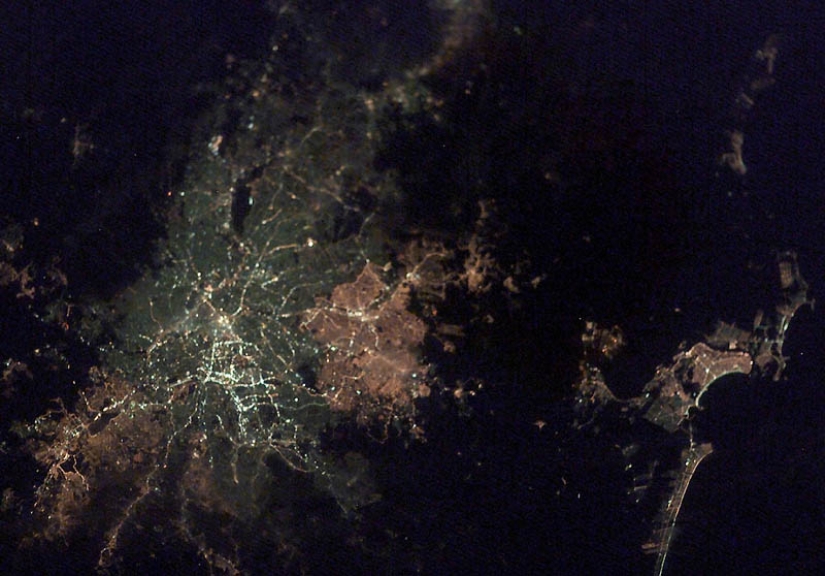 Sao Paulo, Brazil. The largest city in South America with a population of about 17 million people. By color you can determine the type of lamps that illuminate the streets. (NASA)
Sao Paulo, Brazil. The largest city in South America with a population of about 17 million people. By color you can determine the type of lamps that illuminate the streets. (NASA)
 London. (NASA)
London. (NASA)
 California, Mexican California and the Strait of Cortez. (NASA)
California, Mexican California and the Strait of Cortez. (NASA)
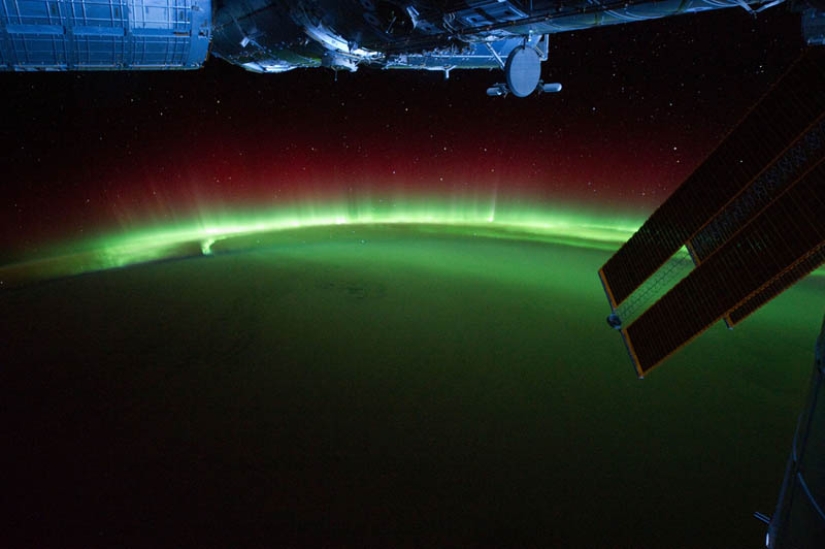 Aurora over the Indian Ocean. (NASA)
Aurora over the Indian Ocean. (NASA)
Recent articles

The next time you're at a dinner party and someone lays out different nuts, take a moment and let everyone know that many of the ...

Discussions have been going on about the origin of the Americans' nickname "Yankee" for a very long time. There are many versions, ...

A nudist cruise isn't just a clothing-optional sea voyage; it's an entire subculture with its own rules, traditions, and ...